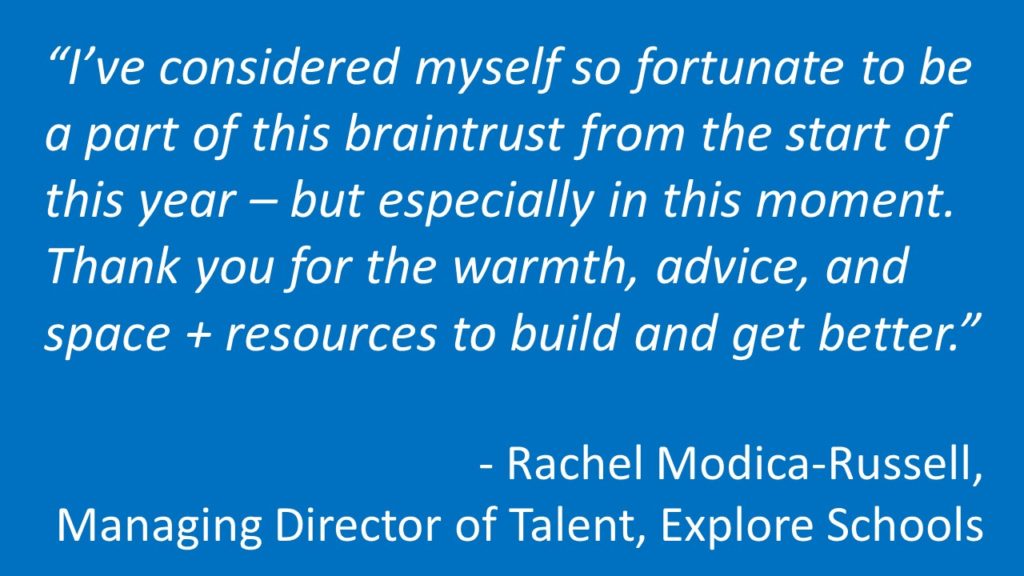Posts Tagged ‘Corona Virus’
Are You a Leader Feeling Stuck Right Now? Ask Yourself These Questions
Leaders make sense of things for others, untangling knots of confusion and ambiguity. This responsibility compounds during a crisis and is even harder when you are feeling like a mess yourself!
To “un-mess” myself, I like to use a strategy that worked for me as a kid – some good old-fashioned self-talk – ala Lev Vygotsky. My grown-up version of self-talk takes the form of questions that I ask and answer myself (I only occasionally do this out loud). The good news is they’ve also worked well for my colleagues and the people I coach – and I hope they will for you too.
1. Am I keeping the mission and values central to every decision I am making? Remembering why you do the work and what you stand for–and will not stand for—are critical to good decision-making and productivity in a crisis. We all need to be grounded or anchored, and this question always gets me back to center.
2. What can I simplify at work, in my life, and for my team? Accomplishing even the simplest things can seem insurmountable when your world is turned upside down. Our economy shutting down, communications rhythms changing, and having your whole “way of working” change overnight has had pretty serious ripple effects. A strong leader works to simplify things for themselves and for their team. Doing so can focus a team and allow them to even feel motivated with newfound direction.
3. How can I work collaboratively to identify bias, blind-spots, and inequities in our decisions and work without thwarting decisiveness? Even if it isn’t within your normal mode, you’ll have to move fast to make decisions and to give direction in crisis. Acting on instinct and doing so confidently provides what seems most needed – guidance. However, our instincts are inherently biased and we have blind spots. We can’t let the need to provide guidance and decisiveness over-ride informed decision-making. Take a second, ask a trusted colleague, mentor or team-member to check your thinking and make sure it’s someone who thinks differently and is willing to challenge you.
4. How am I adding value or support during the interactions that I have? If you’re leading a team, it’s likely that you’re getting bombarded with questions or working to keep people engaged while managing your own stuff (which is very real right now). In this harried time, there’s a big risk that some of these interactions devolve into transactions. Getting things done now is important, but you have to remember that the fight against inequity is an ultra-marathon; and building team and developing people can’t be lost in all of this. Make sure that you are entering conversations and interactions with intention and aiming to add value in as many interactions as possible.
5. Am I keeping my team and those around me appropriately updated (without overwhelming them)? You are likely hearing all sorts of news from every direction – schools are staying closed; the budget situation is going from bad to worse; inequities are deepening, and trauma is reigning. As a leader you have the unenviable position of knowing all of these things. Part of your job is to keep your team updated, but appropriately: giving people the information they need to do their best, transparently, without causing undue stress or concern by sharing too much.
6. How can I consistently be straightforward about where we are and what we still don’t know while still having relentless hope about the future? Mandela taught us that courage was not the absence of fear but the triumph over it; and Stockdale taught us that a brutal honesty about our realities paired with an unwavering confidence that we’ll prevail is key to thriving. Leaders must be clear about both the challenges we’re facing and have confidence that we’ll win in the end—because we have to. Pragmatic optimism is the key, especially in a time when, more than ever, people need the truth and hope.
Getting to clarity is hard enough to do on your own right now, much less for a team or your entire organization, but it’s sorely needed. Engaging in some disciplined reflection before or while you act will ensure that you, and more importantly, your teams and stakeholders will have a much clearer pathway forward – which is exactly what we need right now.
– Jeremy
Special thanks to Gallup and Impact Ladder for inspiring some of these questions.
Leaders, It’s Okay to Take Off the Cape
Leadership is difficult in good times. In times of crisis, this difficulty grows exponentially. This notion has become even more clear through my work supporting a Chief-level leader through the restructuring of a network of schools. This leader’s plate was full before the COVID crisis hit, and their responsibility and leadership scope has essentially doubled as a result of COVID: becoming responsible for orchestrating the network’s response to the abrupt closure of schools, and most significantly designing and implementing virtual instruction. Daily they are responding to questions and concerns from families, teachers, staff, and principals, and are looked to by staff to both assuage fears and set a concrete vision and plan for next steps.
My client reflected on having to spend all of their time being “on.” Conference call after call, zoom meeting after meeting, this leader has to be the one with all the answers, or the plan to find the answers. Staff call them for advice and support, or to complain about the way other team members are responding. And my client has to be there to listen, console and plan. All day, every day.
Yes, great leaders provide security and vision to their teams to manage through crises, but fulfilling that role is incredibly draining. Last week, my client and I reflected on how nice it is for them to have a chance to “take off the cape” during our check-ins: to not have to have all the answers, to be able to complain about how difficult all of this is, and to express disappointment, fear and anger honestly. I was honored that my client saw our check-in as the time for them to take that guard down and to be able to react to and reflect on how the work was weighing on them. It also provided an opportunity for us to brainstorm ways that we can handle the burden of leadership to meet the needs of staff without burning out.
I also saw this as a reflection of what we at Hendy pride ourselves on: walking arm-in-arm with our clients as they design solutions and create programs to better serve teachers and kids. Sometimes that relationship means gently pushing our clients to do something differently; other times it means accelerating full speed ahead on executing a plan. In these crazy times, it has sometimes meant simply providing a space for our clients to “take off their capes”, to reflect honestly about the difficulties of being a leader in crisis, and to know that leading others requires us to take care of ourselves.
-Jess
Celebrating Teacher Appreciation Week 2020
Early May is one of our favorite times of the year. The weather warms, flowers bloom, and teachers are celebrated for an entire week! While we think teachers (and leaders) should be recognized everyday for their tremendous work, Teacher Appreciation Week, this year from May 4 – May 8, is a nice formal opportunity to say thank you.
Though we are teaching, learning, and working virtually, here are 7 ideas for celebrating teachers:
- Send a personal note. More than ever, teachers are inundated with emails and texts. A personal note – sent via the old fashioned, but dependable USPS – can go far for anyone, including your teachers.
- Give a gift. Sometimes, someone taking care of the dinner that night is all you need to make it peacefully to tomorrow. Gift cards, meals from local restaurants, and gift certificates to local businesses are always appreciated. Even a small plant left on the teacher’s doorstep to “decorate their home office” is a meaningful way to say thanks.
- Give time. For leaders, consider cancelling a regular staff meeting and encouraging teachers to use the “found time” to do something for themselves.
- Get families to engage. Ask families to record a short video clip, write notes of appreciation or text pictures of homemade thank you cards.
- Party in a box. Put together a small package of party supplies–balloons, sunglasses, streamers, candy, and a small gift or two–and mail it to each teacher with a label on the outside directing them not to open until a certain date and time. During a staff meeting, have everyone open their boxes simultaneously and start the party!
- Opportunities for input. For some, the greatest recognition is the opportunity to be heard and enhance their impact. Think of ways to bring teachers into decisions–about curriculum, schedules, virtual learning and more.
- Shout-outs. While you may not be physically together, shouting out teachers in meetings, emails, and on social media/websites is a simple, but effective method for letting folks know you value and appreciate them, and a great way to highlight the values you most want your team to exemplify.
Yes, You Can Stop Doing That
Before COVID-19, education leaders prided ourselves in being goal oriented professionals, doing everything in our power to support student success. Working in schools, districts, CMOs, state departments of education and in supporting organizations, we took pride in our commitment to do whatever it takes, knocking through barriers, and always maintaining high expectations for ourselves and others.
But now, that day is over. Or at least on pause. We are balancing full days of meetings with full days of homeschooling our own children, we are nursing ourselves or our families back to health, we are facing fear, frustration, and grief. Our lives have changed and so too must our expectations for ourselves and for others.
Talking with talent leaders across the country, We’re discovering that many simply need to hear, “You can stop doing that. It will be ok.” It’s time to re-prioritize and focus on the purpose of your work, not stay wed to the original plan or program. Schools can be our model. Teachers and principals are learning a whole new way to educate students. They are no longer teaching the same lesson plan, but they are working toward the same standards, ensuring that students are able to learn and grow. District and network leaders need to do the same.
For example, we were recently asked by talent leaders in both a big urban district and in a big charter network about how to continue their robust evaluation systems. While we firmly believe in systems of teacher development, evaluation, recognition and pathways (and have spent most of my career focused on them), now is the time to pause and reassess. It’s the time to ask yourself what the ultimate purpose of your work is and if your system is doing that now. It’s time to simplify and focus on achieving that original purpose, not to MacGyver a complicated and time consuming process. When we talked with leaders about their multiple measure evaluation systems we were direct – your student achievement measures based on interim data aren’t going to be accurate and won’t help teachers get better, so don’t do that. Your families don’t have time to give feedback on teachers, so don’t do that. Your teachers aren’t teaching in ways that align to the observation rubric and had to learn this new method in a day, so don’t do that. Instead, coach and support the adults to do the best they can in a tough situation so they can be their best for kids.
The purpose is always to support people to get better and stay longer.
Is your system doing that now?
As a talent leader, we recommend focusing your time and energy into five priorities:
- Communicate clearly and transparently – State what you know and what you don’t yet know. Be clear about the values that are driving decisions and what is being prioritized right now. Be real about your own fears and your own optimism. And find ways to connect. You can share a video, hold office hours or reach out one on one. In doing so, always focus on the employee’s needs as a person.
- Listen to and support your school leaders – School leaders are struggling through this time, navigating their own emotions and disappointments, and those of their teachers, students and families. Be responsive to their needs and make them your priority. When you need their input, make it as easy as possible for them. Give them a clear proposal and let them react.
- Retain your staff – Have “stay conversations” so people know they are valued and appreciated. Ask them directly through conversations or surveys what their plans are for the fall. Consider how to retain salaries through limited budgets and how to incentivize people through non-monetary compensation.
- Recruit and hire new candidates – Hiring will need to move online, but keep the process moving. Think about how to get hiring managers comfortable granting offers remotely and how to get candidates comfortable to accept offers. Identify how to bring your schools’ unique culture to candidates. For more, check out TNTP’s Virtual Hiring Guide and Fast Company’s article on unconscious bias.
- Recognize and celebrate people – Consider cancelling performance based rewards based on results from 2019-2020 and re-use these funds to recognize teachers now (or returning teachers in the fall). Identify ways to say thank you for the hard work and creativity people are bringing to the work. For example, a personal thank you message, a take-out restaurant gift certificate or a retention bonus at the start of next school year are all effective in letting people know they are appreciated.
As our fearless talent leaders, we want to say thank you for taking care of the adults so they can take care of the children. And, yes, you can stop doing that.
Consulting in the Time of Corona
We are all adjusting. For some, it’s a shift to full-time work from home; for others it’s becoming first-time teachers helping their children stay on track while out of school, whether it be modeling the concept of multiplication with blocks or explaining how the ghost in Hamlet provides examples of foreshadowing; others are essential workers adjusting to added spotlight and stress during the COVID crisis.
And then, there are those who are sick themselves. For almost three weeks in March, this was me. It started with a couple days feeling a bit more tired than usual, but soon turned into a high fever, full body aches, exhaustion, ongoing chills and night sweats. Once the fever broke after four days, I remained exhausted and developed chest tightness and a persistent, dry cough. Around day 13, after watching four seasons of The Sopranos, two seasons of The Great British Baking Show, and of course, Tiger King, I started to feel more like myself, but the cough lingered. I inched back to work, having been completely detached from my computer, let alone clients, the entire time. Finally, at three weeks, I had no symptoms, was back to work fully and celebrated, feeling truly thankful that I never had breathing difficulty or required hospitalization.
I share these less than fun symptoms for the sole reason of letting others know that they are not alone. The virus is rough–my case was “mild”–and takes a long time to clear; but don’t lose faith on day 7 and of course, keep in touch with your doctor regularly to plan your care.
Reflecting on my experience produced a few cliche-heavy reminders for me, that may be helpful to consider if you are ill or caring for a sick loved-one.
- Put your oxygen mask on first. I was completely wiped out and felt physically terrible and emotionally defeated. I hate not feeling productive, am terrible at asking for help, and miserable being dependent on others; but my reality required I not only stop working, managing meals, and walking the dog, but prioritize recovering above all else and accept that it was 100% okay to do so. I had to tell myself, “I will be better for it and my work will be better for it”.
- Communicate. When sick, we often rely on the help of loved-ones around us. Remember: they can’t read your mind. You have to communicate your feelings and needs, and they have to ask a lot of questions to care for you. Be direct, but kind, remember that everyone is stressed and living in uncertainty. Worry shows itself in lots of ways, so give everyone in your life a bit of grace. Be honest with people about the type and frequency of communication. If you want a text message from your 5 best friends each day, let them know how much it means when they check in. If you don’t want to have your phone buzzing all night, let the frequent callers in your life know the schedule you’re trying to keep and when you plan to next reach out.
- Have a plan. Dealing with any illness is stressful, but COVID-19 in particular is new with little scientific study and a tendency to change in intensity quite quickly. I recommend having a plan in place for any potential escalation of symptoms. Specifically, know what hospital/clinic you will go to and how, list who you will contact, plan for any child or pet-care implications, and have already-packed overnight bags by the door.
- Go slow to go fast. Once I started to feel well, I wanted life to immediately return to normal; I longed for the sense of accomplishment from completing a task, a mid-day bike-ride through Prospect Park, a nice dinner with a glass of red wine. I had these dreams, while simultaneously barely able to make it through the day without a 3 hour nap. To those of you sick or recovering, go slow and be kind to yourself. No, things will not be “normal” for a while, but the more you honor your physical and emotional needs now, the sooner you’ll be back to feeling like yourself.
-Grant
Principals and teachers are supporting kids. Who is supporting the principals and teachers?
All across our country, school systems are scrambling to re-invent education. Our school, district and state-level leaders are working to ensure that their families and students are safe. School staff is hustling to make sure that their students have their basic needs met, while simultaneously inventing systems for distance learning. Committed school leaders and teachers, as usual, are laser-focused on supporting families and preserving learning. But who is focused on the grown-ups? Who is orienting themselves towards this whole new way of working?
Remote work and distance learning have thrown a huge curveball at the talent/HR world and, besides ensuring safety and learning, arguably the next most important thing for school systems is to figure how to support and manage a remote workforce (particularly one that has happened in person up until now!). Talent leaders and management teams across the education sector are working to figure things out within their organizations in just a matter of days. It’s enough to make your head spin. I don’t know about you but when a crisis like this happens I can sometimes be guilty of putting my head down like a running back and charging through the problems. I did this during 9/11 and during Hurricane Sandy. This time it’s different, the event is not happening in a day, a week, its looks like it will last months. Putting your head down and charging through might work for a while but this needs to be a heads-up and collaborative effort.
I have the great fortune to be the facilitator for a New York City-based Chief Talent Officer cohort called the “CTO Braintrust”. It’s is a small group of six talent heads from various CMO’s in NYC founded two years ago by Hendy Avenue Consulting with the belief that effective leaders need professional communities of trusted colleagues, where they can learn and grow together. The group functions as a collaborative cohort to share best practices and problem-solve on topics like DE&I, compensation, succession planning, leadership development, performance evaluation, and more. Up until a few weeks ago we met about once a month. Our cohort members have valued a space to collaborate with others wrestling with similar challenges and the group has become a tight-knit community and a trusted soundboard.
Since schools across NYC closed, the CTO cohort has relied on each other more than ever. The group has been coming together weekly and emailing almost daily to support each other in solving the myriad challenges that are facing schools and networks right now. We have been tackling all sorts of questions of various shapes and sizes:
- “What are best practices for remote management?”
- “What will we do about annual reviews if schools stay closed? Can we evaluate remote instruction?”
- “How can we support employee well being in the time of a crisis as they attend to the needs of kids and families?”
- “How can we adjust our policies around sick days to give grace to our employees when they or a family member fall ill to the virus?”
- “How do we interview and hire remotely?”
- “How does the closure impact our performance management?”
- “How are we now thinking about our budgets and compensation?”
- “Can you really just cancel spring break?”
There are thousands of other questions that we are tackling and every time it feels like it is just too much to handle, all I do is remind myself that I am going to be able to reach out to this talented and supportive group of people for help. Some folks have been “lifting up” the beauty within this crisis and sharing the strength of the human spirit and I couldn’t think of a better group to highlight than the CTO Braintrust that all at one time is supporting their network of schools, supporting their own friends and families and supporting each other. There really is something about working together to help endure a crisis. Teamwork makes the dream work, but it also helps get us through nightmares.
-Jeremy
5 Recommendations for Productive Video Conferences
As we collectively respond to COVID-19, many of our desks, classrooms, and conference tables are making way for virtual meeting spaces (Google Hangouts, Facetime calls, Zoom, Microsoft Teams, etc.) that are convenient, relatively easy-to-use and a great avenue for connecting with colleagues. That being said, not all video conferences are equally effective and efficient.
As a virtual-organization, we spend countless hours internally and with clients on video calls. Here are 5 suggestions from our team to ensure your experience is positive.
- Mute your phone! No really, MUTE. YOUR. PHONE. Even if your space is “quiet”, phone and computer microphones pick up tons of ambient noise–let alone the dog barking in the room over and the fire truck sirens whizzing by outside. Muting your phone can also help reduce audio feedback, which our eardrums appreciate! The same is true for typing! If you’re typing on your laptop during a meeting, banging really hard on the keys can end up being really loud. If you’re a key-banger (no shame!), consider hand-writing notes.
- Prep & Set the Stage. Folks understand that for most of us, working from home doesn’t allow working from a physical office. You may be in a bedroom, living room, closet, garage or if lucky enough, outside on a patio! No matter where, be sure to test your wifi signal, check that your computer is charged and test the visual background and lighting. Be sure to look at yourself on camera and clean up what’s behind you that could be distracting and/or not part of a professional work space. Have you spent countless hours tasting whiskeys from around the world to build the perfect home bar? Cool! But don’t have that behind you when video chatting with your 10th grade English class. Also be sure to test that folks can see you on the screen in full lighting, without any weird halos, shadows or distracting reflections. It can help to have a lamp in front of you, vs. behind or above you.
- Plan Ahead. As for IRL meetings (“In Real Life” as the kids say), all online meetings should have a clear agenda and objectives. When meeting virtually, it’s incredibly valuable for those items to be shared ahead of time, along with any handouts or materials that participants may need to reference or would like to print. Certain virtual meeting software programs are less friendly to viewing multiple items on the same screen at the same time, so be prepared for slower review of documents and potential logistics troubleshooting. We recommend having a named facilitator to guide the meeting and a different person as note-taker who can send a detailed wrap-up email afterwards with notes and next steps.
- Intentionally Welcome. Ever the first person to call into a meeting and worry if you’re in the right place at the right time? Meeting leaders can avoid this worry for participants by posting a “landing page” slide–something up on the screen when folks dial-in that says what the meeting is, when the meeting will start and a reminder of any materials that are needed. Since virtual meetings feel different than in-person interactions, try starting with a short “Do Now” activity or ice-breaker to get participants engaging with one another prior to starting formal meeting content.
- Practice. If you haven’t done many virtual meetings, it pays to spend some time practicing by yourself or better yet with a friend or close colleague. Through practicing, you can fine-tune key messages, test logistics and reflect upon your own style and online demeanor. One of our colleagues for example received feedback that they look “stressed” when taking notes on the computer, so they’ve switched to handwritten notes. We’re big fans of using Google docs for live collaboration, but that too requires practice to ensure folks have clear directions and high engagement.
6 Tips for Working from Home
We are in uncertain and stressful times. As the world focuses on slowing the spread of COVID-19, life at home doesn’t stop; and in many cases, is even more challenging than ever as we prioritize the health of our families, care for children home from school, co-work with spouses, remotely engage with colleagues and care for communities on the edge.
While we can’t speak to the overwhelming unrest and anxiety this pandemic is bringing into our lives, we can hopefully help in a small way, by sharing tips on how to work home. Collectively, our team has worked remotely for 20+ years and found the following concepts to be helpful. We encourage you to read below, rest up, stay healthy and care for one another.
Best,
Sarah, Grant, Jessica & Jeremy
- Make a schedule and stick to it. In normal circumstances, we’re big fans of using our calendars to block meetings, calls, work-time, and personal appointments. When at home, especially when it’s not the norm, it’s even more important to build a routine and follow-it. Plan out when you’ll review the quarterly report, check-in with a colleague and take a break for lunch. Distractions are everywhere (suggestion: turn off social media notifications), so be purposeful in spending your time “at work”.
- Start strong. Spending the day working remotely is not the same as that one magical snow day you had in 3rd grade. It can be difficult to differentiate “work-days” from other days when all are spent at home. The solution, set an alarm for the same time each day, take a shower, get dressed and “go to work”. No, you don’t need to throw on that power suit, but avoid wearing your fluffy bunny PJs on a conference call with your boss. How you dress and structure your morning can put you in the right mindset to have a productive day. Similarly, be intentional to log off at the end of the day. While we can check email on our phones, it’s healthy and important to disconnect–allow yourself to fully be present with family, call a friend, dive into a good book or binge watch a trashy tv show.
- Create space. If possible, designate a space for work that you can consistently return to, and then equally important, avoid during non-work time. This is hard for those of us in cramped spaces (hello NYC friends!), but even designating a slice of your dining room table to “work” can help create physical and emotional space between work and the rest of your life. Treat your space like you would your desk at work; keep your favorite snacks or hand lotion in the drawer, put a plant on the surface.
- Stay out of the kitchen. You’re not hungry, you’re bored. Trying having a glass of water.
- Take breaks. If you’re used to working in an office, you may not realize how often you get up, move, and walk during the day. Trips to the water cooler, meetings in conference rooms, and lunches at the corner deli all give you a mental and physical break. Without those natural touchpoints, working from home can lead to long hours in one spot. Not only is this rough on the body, your brain needs chances to reset. Add to your calendar or set a timer reminding you to stand up frequently and take breaks from screens. Try a free Pomodoro system app to remind you to take short breaks. Go for a walk, water the plants, complete a 5 minute workout routine, have a dance party, play with the dog, mediate–whatever you need to recharge.
- Communicate your schedule. Even if this is not your first foray into working from home, it may be the first time there are others in the house while you do so. If others are around (partner, kids, etc.) make sure that they know when you’re available to them, and when you’re not. Something as simple as door open, I’m available, door closed, I’m not. This can help minimize distractions
Interested in learning more, check out these articles from Gallup: Remote Teams & Managing Isolation.








